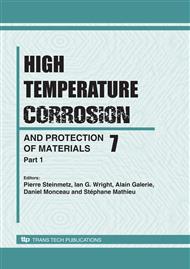p.987
p.995
p.1005
p.1013
p.1023
p.1033
p.1039
p.1047
p.1057
On the Mutual Interaction between Mechanical Stresses and Internal Corrosion during Isothermal and Cyclic Oxidation of Nickel-Base Superalloys
Abstract:
Thermal cycling has been observed to cause a transition from superficial alumina formation to internal oxidation and nitridation, an effect that was shown to depend on the specimen thickness and geometry, which can be described by a spalling-probability model. Once protection by a dense and adherent alumina scale got lost, the internal-corrosion rate is determined by the diffusivity and solubility of nitrogen and oxygen in the alloy. These parameters seem to depend not only on the temperature and the alloy composition but also on the applied mechanical stress. Internal nitridation under a superimposed creep loading was found to follow a higher rate constant than under just isothermal exposure. This effect can probably be attributed to dislocation-pipe diffusion, a mechanism which has been claimed also to be relevant for outward solvent diffusion during internal corrosion, a phenomenon, which was observed as a stress-relief mechanism during various internal-reaction processes
Info:
Periodical:
Pages:
1023-1031
Citation:
Online since:
September 2008
Authors:
Price:
Сopyright:
© 2008 Trans Tech Publications Ltd. All Rights Reserved
Share:
Citation:


